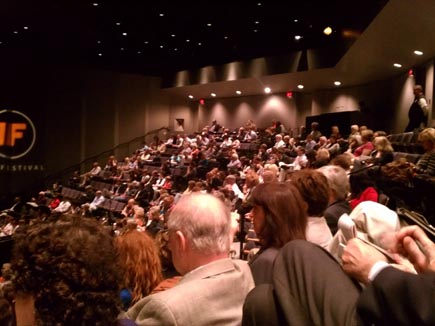Program Scientist for the International Space Station, Dr. Julie Robinson spoke at Idea Festival during an Idea Festival "Mash-up" event for all-access pass holders, sponsors and speakers only.
The topic of the lecture was exomedicine and how the microgravity environment of space affects the development of new medicines.
To begin the lecture, Robinson shared an experiment that took place aboard the space station thanks to the inquisitive young minds of children in a microgravity program that NASA offers. Many children perform an experiment while in elementary school that includes holding a balloon with static electricity charge near a stream of water from a faucet. The water from the faucet bends towards the balloon. The children in the program wanted to know what would happen if a similar experiment were performed in space. Dr. Robinson shared the video of the experiment mentioned on this page to demonstrate that a drop of water began to orbit a statically charged rubber tube aboard the space station. She went on to say that none of the engineers at NASA who plan water usage for astronauts, create toilets for the shuttles, or others who work with water and space expected that result.
She began to speak of bacteria in space. Three things happen to bacteria when it is taken to a microgravity environment: the bacteria become more virulent, meaning one individual becomes more powerful; they multiply faster, meaning the number of them are increased instead of the strength; or some aren't changed at all. Scientists began trying to find how the genetics of the bacteria are affected when they enter space so they could begin to figure out how to use the findings in medicine.
One of the medicinal experiments included trying to develop a vaccine for Salmonella and pneumonia that is more effective. Current vaccines are only about 60% effective and are not as effective for older patients who need them most. Another experiment involves trying to localize chemo treatment for cancer to specific areas instead of having to treat the entire body.
One of the ways the microgravity environment affects the medicine is by keeping sediments from settling and being in the way of the scientists as they try to make micro-capsules. One medicine has been found to be 14 time more effective on prostate cancer. A patent was issued almost 2 years ago, and the creators are trying to raise funds for clinical trials.
Another useful process that seems to work better in space is crystalizing proteins. The crystals grown in space are more pure than crystals grown on earth. Scientists have used the method to create HQl-79, a protein that is important to genetic muscular dystrophy. They are testing it in animal models and have seen dramatic abilities returned to normal.
Dr. Robinson said that many of these experiments never make it to the patient because great ideas sometimes fail to get funding or FDA approval. Sometimes pharmaceutical companies don't think enough people will take the medicine, or the drug may have had bad clinical trials. Technologies make it to patients quicker than drugs do.
She went on to give some examples of technologies developed for the space station that are now used on earth to help people in health matters.
Astronauts needed to be able to give each other ultra sounds but couldn't go to school for years to learn to do so properly. A method was developed to share the images of what astronauts were scanning with a trained sonographer on the ground, so the sonographer could direct the astronauts and read the results. This method is now used to help people in rural areas that do not have access to trained doctors for ultrasounds. Volunteers and organizations can send people in to offer ultrasounds as a trained sonographer directs them via phone or internet communication.
Another technology that is used on earth is a water purification system called UPA, which stands for urine processing assembly. UPA was originally developed for astronauts who can't take drinking water all the way to another planet and have to recycle all water. The same technology was used in Pakistan after the earthquake.
Another vital piece of technology developed from NASA's Dexter robot is the neuroarm, which is used by neurosurgeons to make precise cuts and movements in neurosurgery.
Anyone in Kentucky that is interested in space may want to check out Kentucky Space, who was also at the discussion. According to their web site, "Kentucky Space LLC (KS) is a nonprofit enterprise focused on R&D, educational and entrepreneurial space solutions. We design, build and operate small, moderate cost space payloads and related technologies for potentially high-value missions….including free flying spacecraft and CubeLab
®
R&D modules for the International Space Station. KS collaborates with universities, independent labs and businesses often utilizing their combined resources including technical expertise and physical facilities to greatly extend its capacity and maintain its fast entrepreneurial position."



